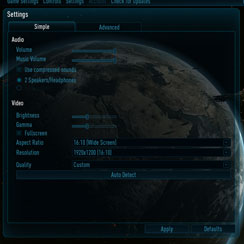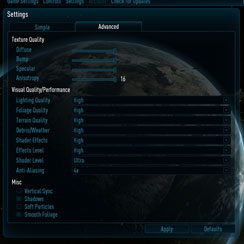Nvidia GeForce 8800 GTS 512
Written by Tim Smalley
December 11, 2007 | 14:27
Tags: #320 #512 #640 #8800 #architecture #bfg #bfgtech #confusion #evaluation #g92 #geforce #gts #gtx #performance #review

Enemy Territory: Quake Wars
Publisher: ActivisionBuilt on an updated version of id Software's Doom 3 engine, Enemy Territory: Quake Wars is a team-based first person shooter that recently obtained the title of being the first game to use John Carmack's megatexture technology: a single texture that spans the entire map.
ET:QW also makes use of many vehicles and large open areas which means the action in view can get really intensive in this team based shooter. It's also the only game in this suite that utilises OpenGL instead of the pretty much industry-standard DirectX API. We used the full retail version of the game patched to version 1.1.
We recorded a timenetdemo that lasts for several minutes during an online game - this used lots of the different graphical effects to create what we've deemed to be a fairly typical slice of action to stress the system. We also created a custom autoexec file that enabled ultra high video settings, over and above that of the standard in game "high".
However, because of some display corruption on the Radeon HD 2900 XT, Radeon HD 2900 XT CrossFire and Radeon HD 2900 Pro configurations, we had to disable soft particles on all cards to give a fair apples-to-apples comparison. It’s worth bearing in mind that you’ll be able to turn this effect on with GeForce 8-series hardware.
Enemy Territory: Quake Wars
1680x1050 4xAA 16xAF, High Quality, No Soft Particles
- Nvidia GeForce 8800 GTX 768MB
- Nvidia GeForce 8800 GTS 512MB
- Nvidia GeForce 8800 GT 512MB
- Nvidia GeForce 8800 GTS 640MB
- AMD ATI Radeon HD 3870 512MB
- AMD ATI Radeon HD 2900 XT 512MB
- Nvidia GeForce 8800 GTS 320MB
- AMD ATI Radeon HD 2900 Pro 512MB
-
-
83.2
-
-
-
72.7
-
-
-
68.0
-
-
-
64.5
-
-
-
57.0
-
-
-
50.7
-
-
-
45.1
-
-
-
39.0
-
0
10
20
30
40
50
60
70
80
90
Frames Per Second
-
Average
Enemy Territory: Quake Wars
1680x1050 8xAA 16xAF, High Quality, No Soft Particles
- Nvidia GeForce 8800 GTX 768MB
- Nvidia GeForce 8800 GTS 512MB
- Nvidia GeForce 8800 GTS 640MB
- AMD ATI Radeon HD 3870 512MB
- Nvidia GeForce 8800 GT 512MB
- AMD ATI Radeon HD 2900 XT 512MB
- Nvidia GeForce 8800 GTS 320MB
- AMD ATI Radeon HD 2900 Pro 512MB
-
-
59.4
-
-
-
46.0
-
-
-
45.6
-
-
-
42.2
-
-
-
42.0
-
-
-
40.0
-
-
-
37.0
-
-
-
32.6
-
0
10
20
30
40
50
60
Frames Per Second
-
Average
Enemy Territory: Quake Wars
1920x1200 4xAA 16xAF, High Quality, No Soft Particles
- Nvidia GeForce 8800 GTX 768MB
- Nvidia GeForce 8800 GTS 512MB
- Nvidia GeForce 8800 GT 512MB
- Nvidia GeForce 8800 GTS 640MB
- AMD ATI Radeon HD 3870 512MB
- AMD ATI Radeon HD 2900 XT 512MB
- Nvidia GeForce 8800 GTS 320MB
- AMD ATI Radeon HD 2900 Pro 512MB
-
-
68.6
-
-
-
60.7
-
-
-
55.1
-
-
-
52.6
-
-
-
43.5
-
-
-
39.8
-
-
-
37.5
-
-
-
32.8
-
0
10
20
30
40
50
60
70
Frames Per Second
-
Average
Enemy Territory: Quake Wars
1920x1200 8xAA 16xAF, High Quality, No Soft Particles
- Nvidia GeForce 8800 GTX 768MB
- Nvidia GeForce 8800 GTS 512MB
- Nvidia GeForce 8800 GTS 640MB
- Nvidia GeForce 8800 GT 512MB
- AMD ATI Radeon HD 3870 512MB
- AMD ATI Radeon HD 2900 XT 512MB
- Nvidia GeForce 8800 GTS 320MB
- AMD ATI Radeon HD 2900 Pro 512MB
-
-
47.9
-
-
-
40.0
-
-
-
37.0
-
-
-
35.6
-
-
-
34.6
-
-
-
32.7
-
-
-
31.8
-
-
-
27.2
-
0
10
20
30
40
50
Frames Per Second
-
Average
Enemy Territory: Quake Wars
2560x1600 0xAA 16xAF, High Quality, No Soft Particles
- Nvidia GeForce 8800 GTX 768MB
- Nvidia GeForce 8800 GTS 512MB
- Nvidia GeForce 8800 GT 512MB
- Nvidia GeForce 8800 GTS 640MB
- AMD ATI Radeon HD 3870 512MB
- Nvidia GeForce 8800 GTS 320MB
- AMD ATI Radeon HD 2900 XT 512MB
- AMD ATI Radeon HD 2900 Pro 512MB
-
-
62.6
-
-
-
59.4
-
-
-
47.5
-
-
-
42.9
-
-
-
42.7
-
-
-
41.5
-
-
-
40.4
-
-
-
33.7
-
0
10
20
30
40
50
60
Frames Per Second
-
Average
Enemy Territory: Quake Wars
2560x1600 4xAA 16xAF, High Quality, No Soft Particles
- Nvidia GeForce 8800 GTX 768MB
- Nvidia GeForce 8800 GTS 512MB
- Nvidia GeForce 8800 GT 512MB
- Nvidia GeForce 8800 GTS 640MB
- Nvidia GeForce 8800 GTS 320MB
- AMD ATI Radeon HD 3870 512MB
- AMD ATI Radeon HD 2900 XT 512MB
- AMD ATI Radeon HD 2900 Pro 512MB
-
-
43.7
-
-
-
38.5
-
-
-
35.1
-
-
-
31.9
-
-
-
28.5
-
-
-
27.7
-
-
-
26.2
-
-
-
21.3
-
0
10
20
30
40
Frames Per Second
-
Average
Quake Wars reveals some more chinks in the GeForce 8800 GTS 512’s armour, as performance really tails off when you push anti-aliasing up to high sample rates like 8xMSAA. It’s the same situation again, whereby the card performs pretty well up until the point when memory bandwidth and anti-aliasing sample rates become the limiting factors.
With that said though, even with only 4xMSAA applied in this title, the GeForce 8800 GTS 512 doesn’t deliver anywhere near the kind of performance you’ll get from a full-blown GeForce 8800 GTX. You can see from our 2560x1600 0xAA results that, when there is no anti-aliasing, performance doesn’t suffer – the same is true at 1920x1200 and 1680x1050 too, which were both tested even though we’ve not included graphs on this page.











Want to comment? Please log in.